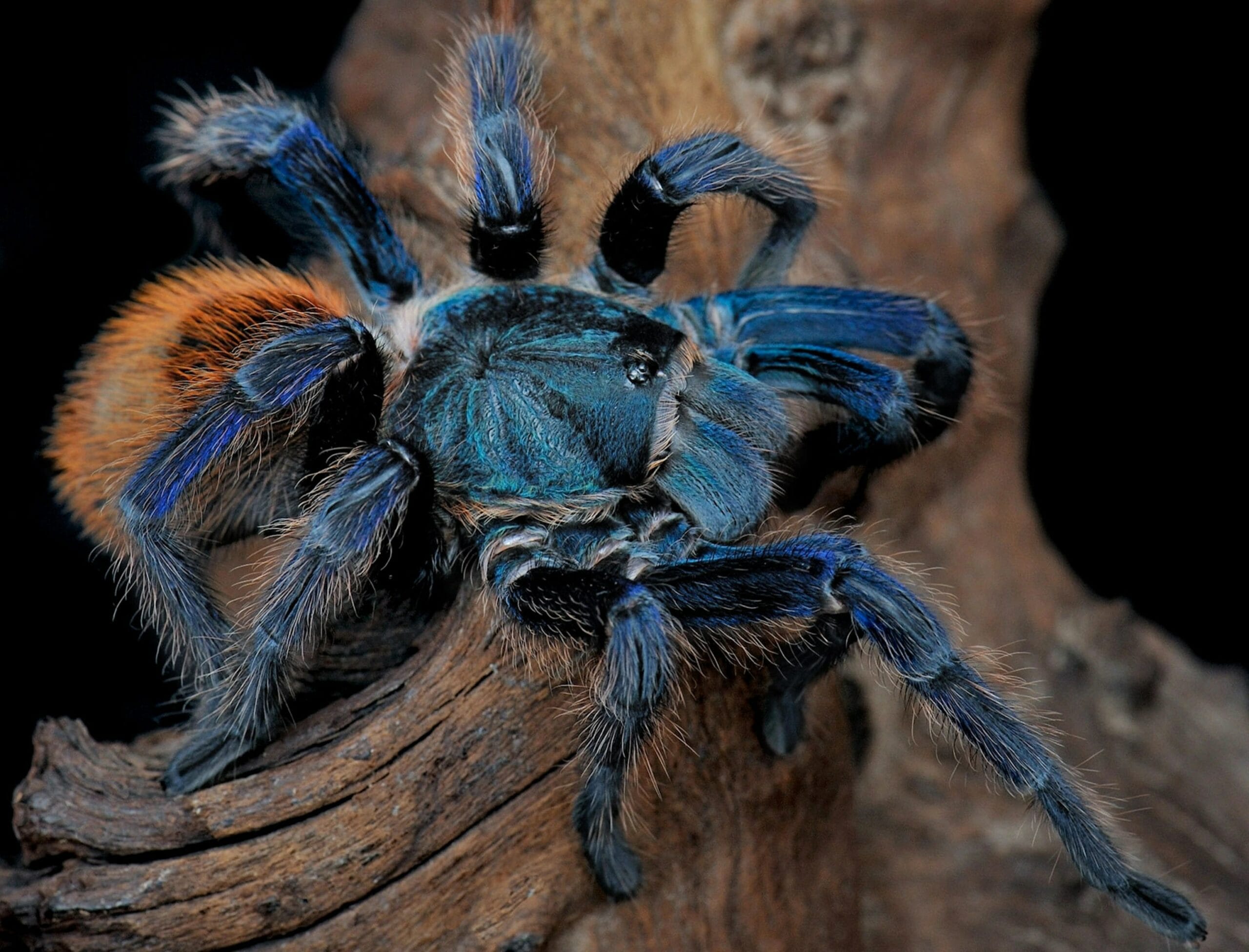Dive into the captivating world of blue cobalt tarantulas! These mesmerizing creatures are renowned for their radiant blue legs and intriguing personalities. This comprehensive guide equips beginners with the knowledge necessary to care for these blue wonders, from habitat setup to dietary needs. Let’s embark on your tarantula-keeping journey!
Unveiling the Allure of Blue Cobalt Tarantulas
Envision a tarantula boasting electric blue legs—that’s the captivating charm of the blue cobalt tarantula, a true gem hailing from the rainforests of Southeast Asia. Often referred to as “electric blue tarantulas” or “Singapore blue tarantulas,” their vibrant hue is a testament to their visual appeal.
Recreating the Rainforest Haven
Imagine lush rainforests with towering trees and a dense carpet of leaves—this is the natural habitat of the blue cobalt tarantula. As burrowers, they excavate cozy retreats in the damp earth, relying on the rainforest’s humidity to maintain their comfort.
Size and Appearance: A Closer Look
These tarantulas are not your average, diminutive spiders. Reaching a leg span of around 5 inches, approximately the width of your hand, they command attention. Their bodies exhibit a light gray shade, while their abdomens bear distinctive gray markings that resemble arrows. However, the most captivating feature is undoubtedly their dazzling blue legs.
Temperament: Shy, Speedy, and Defensive
Blue cobalt tarantulas are best described as “homebodies,” spending a considerable amount of time secluded in their burrows. However, this seemingly docile nature belies their ability to defend themselves with surprising agility and potent venom. Their lightning-fast reflexes and territorial instincts make them a less-than-ideal choice for novice tarantula enthusiasts.
Understanding the Venom: A Note of Caution
While a blue cobalt tarantula’s venom is unlikely to warrant a hospital visit for humans (unless allergies are a concern), it’s not a sensation you’d welcome. Expect intense pain, muscle cramps, and noticeable swelling. In the unlikely event of a bite, seeking medical attention is always the safest course of action.
A Carnivore’s Diet: What’s on the Menu?
True to their wild counterparts, these tarantulas relish a diet of live insects. Crickets, appropriately sized roaches, and other invertebrates make up their primary meals. Adult tarantulas typically feed once a week, while their younger counterparts, akin to growing teenagers, require more frequent nourishment.
Crafting the Ideal Tarantula Dwelling
Creating the perfect habitat is paramount to ensuring your blue cobalt tarantula thrives.
Essential Elements:
- Security and Space: Opt for an escape-proof enclosure (they’re surprisingly clever!) that provides ample space for burrowing.
- Substrate Depth: A minimum of 6 inches of substrate, ideally a blend of coco fiber and peat moss, is crucial for their burrowing needs.
- Hiding Spots and Humidity: A cozy hide offers a sense of security, while maintaining humidity levels between 70-80% replicates their rainforest home.
- Temperature Regulation: These tarantulas prefer warmth. Strive for a temperature gradient within the enclosure, with one side at 80-85°F and the other at 70-75°F.
Hydration is Key:
- A shallow, tip-proof water dish is essential, providing both a drinking source and aiding in humidity control.
Ethical Considerations: Protecting Blue Beauties
Unfortunately, the pet trade sometimes involves unethical sourcing practices, including capturing blue cobalt tarantulas from the wild. When acquiring one, ensure it’s from a reputable breeder who prioritizes ethical and sustainable practices.
Dispelling Myths: Fact vs. Fiction
Let’s debunk some common misconceptions surrounding blue cobalt tarantulas:
- Myth: They’re inherently aggressive.
Fact: While more defensive than some species, they’re more inclined to retreat than attack. - Myth: Their venom is deadly to humans.
Fact: While painful, their venom is not lethal unless an allergic reaction occurs. - Myth: They’re suitable for beginner tarantula owners.
Fact: Their specific care requirements and defensive nature make them a better fit for experienced keepers.
This glimpse into the world of blue cobalt tarantulas, with their unique beauty and fascinating behaviors, Hopefully, it highlights the importance of responsible ownership and informed care. Welcoming one into your home is a decision that requires careful consideration and a commitment to providing the best possible environment for these captivating creatures.
Cobalt Blue Tarantula Toxicity: Unveiling the Truth About Their Venom
Cobalt Blue Tarantula Venom: How Dangerous Is This Stunning Spider?
Don’t let their striking beauty fool you—the cobalt blue tarantula, while captivating, possesses a venom-laced bite that serves as a stark reminder of its wild nature. Thankfully, for humans, it’s more of a painful nuisance than a deadly threat.
More Ouch Than Lethal: While not fatal to humans, a cobalt blue tarantula’s venom delivers a potent cocktail of excruciating muscle cramps and inflammation. Imagine a bee sting amplified significantly—a memorable experience you wouldn’t want to repeat.
Interestingly, scientists suggest that these tarantulas exhibit a remarkable ability to regulate the amount of venom injected based on the perceived threat. This implies that humans, being far larger than their usual prey, likely receive a less potent dose—a painful deterrent rather than a lethal blow.
Research reveals that their venom contains glutamic acid, a neurotransmitter, at a concentration of 0.97%. This compound is thought to play a key role in the intense pain experienced after a bite. Nature, it seems, has equipped them with a potent defense mechanism designed to deter potential predators.
While fatalities are extremely rare, allergic reactions, although uncommon, can occur. Should you experience difficulty breathing or severe swelling after a bite, seek immediate medical attention.
Delving into Cobalt Blue Tarantula Ownership: A Balanced Perspective
Cobalt Blue Tarantula: Stunning Beauty, Experienced Owner?
The cobalt blue tarantula, with its mesmerizing blue legs, has become a sought-after addition to the world of exotic pet enthusiasts. However, their stunning appearance often overshadows the reality of their care requirements—a responsibility best suited for experienced keepers.
Docile Yet Demanding: While generally considered docile, cobalt blue tarantulas possess specific needs that necessitate an experienced hand. Their care is akin to cultivating a delicate ecosystem, requiring a deep understanding of their natural habitat and behaviors.
Beginner Beware: The allure of their beauty often leads aspiring owners to underestimate the commitment involved. Handling these tarantulas, even for seasoned keepers, requires caution. Their venom, while not deadly to humans, can deliver a painful bite, a risk not to be taken lightly, especially by novices.
Beyond the Blue: Responsible ownership goes beyond admiring their striking appearance. It entails replicating their Southeast Asian rainforest habitat, providing ample space for burrowing, maintaining ideal humidity and temperature levels, and offering a diet of live insects.
Not Your Average Pet: Cobalt blue tarantulas, unlike conventional pets, demand respect and observation rather than constant interaction. Their care is a rewarding endeavor, but it’s one best suited for those willing to invest the time, knowledge, and resources to meet their specific needs. Remember, responsible ownership prioritizes the well-being of the animal over fleeting aesthetic appeal.
Unveiling the Lifespan of Cobalt Blue Tarantulas: Secrets to Longevity
Cobalt Blue Tarantula Lifespan: Unveiling the Secrets to Longevity
One of the fascinating aspects of cobalt blue tarantulas, apart from their captivating appearance, is their lifespan. In the realm of invertebrates, they boast impressive longevity, particularly the females, who often grace their keepers with their presence for well over a decade.
Ladies Outlive Gents: A striking difference exists between the lifespans of male and female cobalt blue tarantulas. Females, the reigning matriarchs of their species, can live for an average of 15 to 18 years in captivity, with some reaching a remarkable 20-25 years. Males, on the other hand, have a shorter lifespan, averaging 5 to 6 years, although some may live for 10 to 15 years under optimal conditions. This discrepancy is a common trait observed across numerous spider species.
Captivity vs. Wild: The controlled environments we provide play a significant role in their extended lifespans. In their natural habitats, cobalt blue tarantulas face a myriad of threats—predators, disease, and competition for resources—that significantly impact their survival. However, in captivity, with proper care, a consistent food supply, and a secure environment, they often outlive their wild counterparts.
A Lifetime of Molting: Throughout their lives, these tarantulas undergo molting, shedding their exoskeletons to accommodate growth. This process, essential for their development, is a testament to their remarkable ability to regenerate and renew.
Understanding the factors that influence their lifespan—sex, environmental conditions, and the quality of care provided—allows us to appreciate the commitment involved in keeping these fascinating creatures. Their longevity is not just a testament to their resilience but also a responsibility for those who choose to share their lives with these captivating blue wonders.

















1 thought on “Blue Cobalt Tarantula Care: The Complete Guide for Beginners”
Comments are closed.